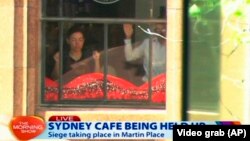One hostage the Sydney siege gunman failed to take this week was social media.
After traditional media refused to air or print details of phone calls his hostages made, Man Haron Monis turned to Facebook and YouTube, forcing his captives to use their personal accounts to issue his demands to speak to the prime minister and spread claims that he'd planted bombs around the city.
Those messages never went viral. Not only were social media companies working with Australian police to block posts, but the broader online community practiced self-censorship to a degree that surprised many experts.
"This was a new situation for us," said a source at one social media company, requesting anonymity because he was not authorized to speak on the record.
"Even as we tried to track down what was coming from where and whether it was genuine, there were a good deal of people reporting posts and just refusing to pass things on."
Police killed Monis, a self-proclaimed Muslim cleric, when they stormed the Lindt Chocolate Cafe early Tuesday to free hostages held at gunpoint for 16 hours. Police are investigating whether two hostages who also died were killed by Monis or were hit in the crossfire.
Social media has 'grown up'
The siege, believed by social media sources to be unique in how the hostage-taker used captives to try to disseminate his message for several hours, showed that social media had "grown up," experts said.
The behavior of most Internet users during the crisis contrasted with notions of new media as a "Wild West" where vigilantes, such as those who spread unverified, and ultimately incorrect, photos on social networking site Reddit Inc. of the Boston Marathon bombers, had free reign.
"Here was a guy who had the eyes of the world on him thanks to the live video feed (of the cafe) and he couldn't get a tweet or a Facebook post to resonate," said Stephen Dann, senior lecturer in the research school of management at the Australian National University in Canberra.
"I think the message for others trying the same tactic is that social media is more socially responsible than many had thought."
As the siege unfolded, several frightened hostages recorded YouTube videos using cafe worker Joel Herat's account, which were then flagged on Twitter. Others posted frantic updates on their Facebook pages.
Facebook Inc., Google Inc.-owned YouTube and Twitter Inc. all declined to comment in detail on the siege, saying they were part of a formal inquiry into the hostage drama.
"During the situation on Monday we responded to the direction and instructions from law enforcement and we will continue to cooperate with their ongoing investigation," a Facebook spokeswoman said.
Police declined to comment. During the siege, officers would only say they were monitoring social media.
Facebook post
The first Facebook post from Marcia Mikhael, a bank worker, read: "Dear friends and family, I'm at the Lindt Cafe at Martin Place being held hostage by a member of the ISIS. The man who is keeping us hostage has asked for small and simple requests and none have been met. He is now threatening to start killing us. We need help right now. The man wants the world to know that Australia is under attack by the Islamic State." ISIS is another term for the Islamist group.
Mikhael's niece quickly added a plea to her aunt's page, urging people not to share any messages released by the hostages "as the terrorist is using them as a means of communication. This could put my aunty and the others in grave danger."
Most Internet users complied and many reported Mikhael's posts to Facebook, resulting in them being removed. Facebook was also able to monitor accounts as the siege progressed with a list of names relevant to the siege provided by police.
YouTube's round-the-clock team dealing with content complaints got fast warning of videos in which four female hostages outlined Monis' demands.
The "flags" available to users to report unlawful or inappropriate content include one aimed at blocking content that promotes terrorism.
"The majority of the videos were flagged by the YouTube community very, very fast and we were able to take them down very quickly," said a source at the company.
A source with knowledge of Twitter's response said the company was unaware of any direct tweets from the hostages, although some users tweeted links to the YouTube videos.
Official accounts
Twitter pointed users toward official users, such as the New South Wales state police. Many users promoted those accounts and prompted others not to retweet any video tweets.
"It was a level of self-censorship by users that was nothing that Twitter was involved in directly," the source said.
Monis' attempt to use social media may have not only failed but also backfired. A two-way street meant police gained critical information about what was happening inside the cafe from the live updates.









